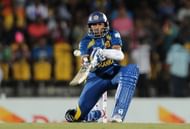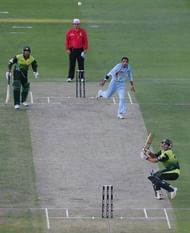In the modern era, the T20 format has truly joined cricket and entertainment, to form ‘cricketainment’
‘The endgame’; ‘An uncalled chaos’; ‘The game’s all new low’; ‘Shorter, simpler, sillier’ – T20 cricket received an introduction to the game as if it was a disowned sibling in a royal family.
To be fair, if one could really fall back to the early 2000s, the advent of this quick-flick format did have its fair share of clinging uncertainty with it – and why not!
Right from the game’s initial introduction, there have been only a select few moments when cricket really yearned for a radical change.
When the change did come last time, it resulted in the birth of a pragmatic torch-bearer for the coming generations in the form of one day internationals.
While the two formats – Tests and ODIs – had found a way to co-exist and succeed for over three decades, T20 sprang up as a competition that was deemed unworthy to keep up the game’s identity which remained mostly undiluted.
Now, when you look back at what the new kid on the block has achieved, in what has been close to a decade signified by T20 delirium, it is almost incredible the way it has kept on reinventing new means of cricketing genius, the same genius that was always up for display, yet was never as valued as the ‘traditional play’ for its stopgap produce on the traditional 22-yard strip.
Gradually, it became clear that though T20 cricket’s impact was not acknowledged widely, the fans’ pull towards the format meant that the format’s future looked bright.
And here we are, reaping from a game that now has a changed definition and a varied approach. However, this decade of revolution has seen its own set of imminent battles that T20 fought and emerged as an outright conqueror.
Let’s map the evident markers in the nurturing of the T20 game that went on to bring a mini-cricketing renaissance in the past few years.
Where it all started
It is rather difficult to accept the fact that arguably the most adored cricketing format was only a product of an act of desperation. While the England Cricket Board were always on the lookout for a window to test a shorter one-day format, it was only when the Benson and Hedges Cup was scrapped in 2002 that serious consideration came up for formal discussions.
The English cricketing authorities were looking to pen down a platform to reinvigorate the game’s dwindling popularity and to boost sponsorship revenue model of the game. However, it took Stuart Robinson, the ECB marketing manager, to take the agenda of introducing a proposed 20-over per side format to the execution phase in 2001.
Then all it required was an approval from the authorities that came in the form of 11 votes to 7 in the favour of the all-new T20 format. The carnival began with the Twenty20 Cup in 2003 – and rest as they say is history!
The rule tweaker
Whoever was sketching the T20 picture on the outset must have been one of a kind cricketing bully. While 20-overs a side was an eye-opener for the batting line-ups, the stringent field restrictions and smaller grounds were definitely built to baffle the best of bowling units in the world.
Switching from a cozy dressing room to a snazzy dugout had added its own share of anxiety too.
Yet, with the amped anxiety levels being the USP of the format, one had to adapt to these unforeseen circumstances. The ODI slog-over onslaughts soon phased out into longer twenty-over routines while the real impact of economical bowling was found in the game’s shortest format.
Cricket on the other hand, was introduced to its most creative stage of the game’s evolution. For the first time in its history, the game was dictating its set of rules and not the other way around.
Of Strategic leaps and defying the impossible
With looming adversities, comes an opportunity to invent and evolve – and T20 was the one screaming for immediate changes. While it was initially asserted as a game of mindless hitting and entertainment for an idle mind, the game was soon invaded by a lot of thinking cricketers, now widely celebrated as the path-breakers in the format.
The margin of error was shrinking by the day and the smallest of mistakes were dissected with a rather scathing analysis. The first to react to these seismic changes were the batsmen that redefined the art of shot-making to a whole new extent.
With paddle-sweeps being a norm, situations conducive for playing lofted drives and traditional heaves used at utmost regularity – T20 introduced a new age of batting hostility that had its own set of conditional calculations attached to it. The class of a Laxman wrist-flick or a Ganguly cover-drive was soon overshadowed by a Dil-scoop or a trademark KP switch-hit – T20 had invited the unorthodox to assume centre stage.
Meanwhile, the bowlers were not to be left much behind in finding the antidotes to counter the cavalier batting ethics for a long time.
The yorkers on the base of leg-stump were soon accompanied by an array of full-length deliveries pitched right on the tramline on the off-side, while looping bouncers were integral in curbing the big hits, and bowling the same line and length, the traditional way, was just unacceptable.
Mystery spinners soon became a priceless commodity and variations were accepted for its virtues of delivering the goods in a 4-over spell. Bowling soon transformed into an art from a mere routine on a flat deck and contests between the bat and ball had a hint of unpredictability to it.
Moreover, further light was shed on improving fitness and fielding standards that were now too important to be left on mere chance. With the winning margins often separated by fewest of runs, every saved boundary or extra single was a major incentive.
Result? One may never find an Inzamam or a Ramesh Powar making into a top-notch T20 outfit. It was truly shaping out to be a survival of the fittest!
Captaincy too had to deal with a major reality check in the early days of the format. Soon, skippers were seen experimenting with close-in fielders in attempt to guard against the newly conjured fancy hits.
Even opening the bowling with a spinner to curb early fireworks was an infectious method explored across the game. Thinking on the feet became a necessity in every prospective captain’s CV and trusting one’s sheer instincts was regarded as the best way out of a looming catastrophe.
Suddenly, the game was dependant on the pure impulsive nature of the brain and reactive cricket was more of a mainstream phenomenon. Cricketing strategies have certainly seen their identity scripted all over again, thanks to the influx of T20 frenzy in the past decade.
Introduction of the T20 specialist – A cricketing irony
Specialists in a T20 game are subject to a completely new definition. Having already analyzed the skill-set possessed by the new-age 20-over talismans, the role of a specialist is meant to be bestowed upon that one player who can perform the bit-part role in the side.
It sounds ironical when compared to a ‘specialist’ in the two traditional formats, as a T20 specialist is expected to be nothing more than an player who can adopt different roles for the side.
Players like Chris Gayle, Kieron Pollard, Ryan ten Doeschate and Azhar Mahmood – all of them renowned for their T20 craft – have found peace in carving a career out of playing in 3-4 T20 leagues in a calendar year.
And as bullish it may sound, but the niche of T20 specialist will only see a wider acceptance in the coming years as individuals who fail to thrive in the longer format of the game will certainly opt for this tempting career option.
T20 life cycle – from a prospective discard to a life support of Tests and ODIs
With Test and ODI cricket’s popularity slowly succumbing to the growing appeal of shorter sports worldwide, one must note T20′s role as a potent catalyst in rejuvenating the game of cricket over the last few years.
With cricketers now encountering almost unreal targets and required run rates in the T20 formats, it was about time when they took their craft to the Tests and ODI arenas.
T20 stalwarts like Chris Gayle, Shahid Afridi, Sunil Narine and Martin Guptill have had their issues with adjusting to other forms of the game. However, on their day, they have went on to snatch even Test and ODI victories, thanks to their aggressive, T20-like performances.
In fact, it’s the overall mentality of the current set of international players that has seen a major overhaul, which eventually does reflect on their performances. With drawn Test matches witnessed at an average of not more than 1 in every 4-match series, the teams are now looking to head out in every format to fight for a result.
T20 has also seen the smaller nations coming to the party, for e.g., the recent thrashing of New Zealand at the hands of Bangladesh which grabbed the cricketing headlines, or the world-beaters of the past, West Indies, finally achieving a slice of their erstwhile glory by winning the T20 World Cup.
Also, the evolution of franchise based competitions like the Indian Premier League and KFC Big Bash League have seen new stars making a name for themselves, inadvertently creating their own path for national team selection.
Over the years, T20 has proved that it has never been in the race to topple Test or ODI cricket formats. In fact, all it has done is provided a fresh outlook and a source of unearthing new cricketing talent that was left untested so far.
Of lavish league theatres, diverse cultures and unfamiliar decibel levels
With T20 providing a 3-hour package of ‘cricketainment’, it soon became a breeding ground for the moneymakers that revisited the revenue model of the game.
Gradually, T20 became the wagon that has truly started globalizing cricket as several leagues have set up their outlets across the globe, IPL being the most fruitful of the money-minting machines, having hosted 6 larger than life events so far.
Yet, apart from the unavoidable clamour attached to the event, leagues like the IPL have only helped to stamp financial as well as cultural footprints on almost every cricket-playing nation.
Ask a cricketing connoisseur ten years ago if he’d have wished to see Ricky Ponting and Sachin Tendulkar in the same batting line-up and he would have dismissed it as a ridiculous fantasy. Yet, now we see legends pairing up with each other, crossing borders and contrasting cultures – all for the love of the game.
Even if it’s for a comparatively shorter span, it must be a learning experience for a bowler like Ishant Sharma to bowl alongside the legend that is Dale Steyn. It’s the platforms like these that assist cricketers to improve under the guidance of their role models and it remains the biggest gift this format has presented to the game of cricket.
How much has T20 changed the game of cricket? Well, one may never have an objective answer to that.
But having said that, the impact of T20 has been so resounding, that changes effected in one are now unconsciously implemented on the all the other formats of the game.
Ten years down the line, it looks like the disowned sibling is finally feeling at home.
Although it may not have the Scorcese-esque traditional swagger that surrounds the Test match arenas, yet the shortest format of the game does have the typical Spielberg-like grandeur associated with it.
And at the end of the day, all that counts is a blockbuster at the box-office.
Read more about such events which altered the way cricket was played over the years - The moments that changed cricket forever.
Brand-new app in a brand-new avatar! Download CricRocket for fast cricket scores, rocket flicks, super notifications and much more! 🚀☄️





